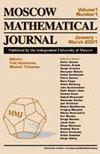超图矩阵模型
IF 0.5
4区 数学
Q3 MATHEMATICS
引用次数: 1
摘要
经典的N×N厄米矩阵的GUE矩阵模型配以高斯测度,可以用多边形边缘胶合得到的格数对可定向拓扑曲面进行计数。我们介绍了GUE矩阵模型的一种变体,该模型列举了由多边形胶合得到的某些边分枝的连续波配合物。我们通过将高斯测度替换为与生成枚举均匀超图的函数相关的形式化模拟来做到这一点。我们的主要结果是计算幂迹期望的三种不同方法。特别是,我们证明了我们的矩阵模型具有拓扑展开性。本文章由计算机程序翻译,如有差异,请以英文原文为准。
Hypergraph Matrix Models
The classical GUE matrix model of N×N Hermitian matrices equipped with the Gaussian measure can be used to count the orientable topological surfaces by genus obtained through gluing the edges of a polygon. We introduce a variation of the GUE matrix model that that enumerates certain edge-ramified CW complexes obtained from polygon gluings. We do this by replacing the Gaussian measure with a formal analogue related to generating functions that enumerate uniform hypergraphs. Our main results are three different ways to compute expectations of traces of powers. In particular, we show that our matrix model has a topological expansion.
求助全文
通过发布文献求助,成功后即可免费获取论文全文。
去求助
来源期刊
CiteScore
1.40
自引率
0.00%
发文量
16
审稿时长
>12 weeks
期刊介绍:
The Moscow Mathematical Journal (MMJ) is an international quarterly published (paper and electronic) by the Independent University of Moscow and the department of mathematics of the Higher School of Economics, and distributed by the American Mathematical Society. MMJ presents highest quality research and research-expository papers in mathematics from all over the world. Its purpose is to bring together different branches of our science and to achieve the broadest possible outlook on mathematics, characteristic of the Moscow mathematical school in general and of the Independent University of Moscow in particular.
An important specific trait of the journal is that it especially encourages research-expository papers, which must contain new important results and include detailed introductions, placing the achievements in the context of other studies and explaining the motivation behind the research. The aim is to make the articles — at least the formulation of the main results and their significance — understandable to a wide mathematical audience rather than to a narrow class of specialists.

 求助内容:
求助内容: 应助结果提醒方式:
应助结果提醒方式:


